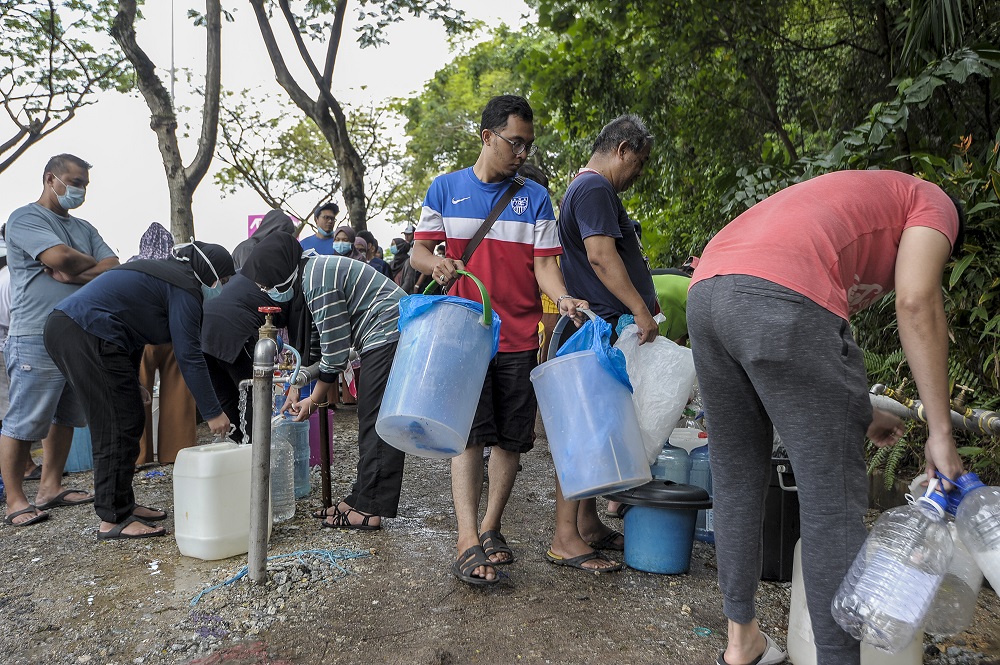KUALA LUMPUR, Sept 7 — The ongoing water cuts estimated to affect 1.2 million people in Selangor, Kuala Lumpur and Putrajaya have begun to turn around four days after it started.
But for many residents and workers in seven regions across the greater Klang Valley, coming to terms with water disruptions has become an uneasy norm.
Data from last year’s National Water Services Commission (SPAN) Water and Sewerage report showed a total of 11,074 unscheduled water interruptions in 2018 in Selangor and Kuala Lumpur alone.
However, the number actually went down compared to the 19,061 incidents of unscheduled water interruptions in 2017.
Compare the figures too to scheduled interruptions, which stood at 770 in 2018, and 798 in 2017.
While the numbers indicate that water disruptions remain a persistent problem caused by burst pipes, leakages and pollution as is seen in the current case, the authorities have promised to crack down harder to address these woes.
How will it turn out? Let’s take a look at the notable scheduled and unscheduled water cuts that have occurred within the Klang Valley since 2016, starting with this year.
2020
On March 17, a day before the government imposed the movement control order (MCO) in response to the Covid-19 pandemic, Air Selangor Sdn Bhd announced the closure of four water treatment plants — namely SSP1, SSP2, SSP3 and Rantau Panjang — that would disrupt the flow of water to certain areas in the national capital and Malaysia’s most populated state, after detecting odours in its raw water supply from rivers.
Thankfully, the water company announced the same day that it had resolved the odour pollution and that all four plants were able to resume operations.

2019
On April 18, SPAN sent out a warning that 4.14 million people will be affected by water supply disruptions for up to four days from April 24, due to the shutdown of the Selangor River Phase 2 Water Treatment Plant for upgrading works.
It was touted as the biggest water disruption in Selangor’s history at that time and Air Selangor even advised residents to store up to two days’ worth of water.
Taps were able to be turned out again like normal by April 26, half the time projected by SPAN.
But just three months later, Klang Valley residents were again notified of a scheduled water disruption from July 23 to July 26 due to much needed upgrading works at the Sungai Selangor Phase 1 (SSP1) Water Treatment Plant, which was to be carried out during the four-day period.
The upgrading works, however, were postponed after odour pollution was detected at the Phases 1, 2 and 3 of the Sungai Selangor Water Treatment Plant and the Rantau Panjang Water Treatment Plant on July 19.
This forced all three plants to shut down, causing water disruptions to 1,133 areas and 1,166,842 consumers in Kuala Lumpur, Petaling, Klang/Shah Alam, Kuala Selangor, Hulu Selangor, Gombak and Kuala Langat.
A code red emergency was then subsequently activated. Water supply was slowly restored beginning on July 20, with full restoration achieved five days later on July 25.
It was reported that the water cuts were due to diesel pollution related to sand mining activities.
However, five months later on December 22, Air Selangor announced the complete shutdown of the Sungai Semenyih water treatment plant due to another odour pollution, traced to the illegal disposal of waste containing solvents at the inlet around the Indah Water Konsortium plant.
The closure affected water supply to 336,930 consumer accounts in Petaling, Hulu Langat, Kuala Langat and Sepang.
This incident led to SPAN chairman — at that time Charles Santiago — calling for a full police investigation.
2018
On March 2, Ai Selangor’s predecessor Syarikat Bekalan Air Selangor Sdn Bhd (Syabas) announced that they are shutting down the Sungai Selangor Phase 3 Water Treatment Plant (SSP3) for much-needed repair work.
Initially, the commission announced that a total of 427 areas in Kuala Lumpur, Petaling, Klang, Shah Alam, Gombak, Hulu Selangor and Kuala Langat would suffer a two-day water disruption starting March 6.
Residents were told to store water for the scheduled cut. But just when it seemed that supply would be back on March 7, ahead of schedule, a surge vessel system at the SSP3 exploded injuring five staff, and extending the water disruption.
Water supply was finally fully restored to the affected areas by March 10.
In October, Syabas announced a scheduled water cut to Petaling, Hulu Langat, Sepang, and Kuala Langat, affecting some 340,000 account holders that could last 72 hours starting from October 9.
This was caused by much-needed repairs to be carried out at the Sungai Semenyih Water Treatment Plant.
2017
On November 4, Syabas announced that several areas in Klang, Shah Alam, Kuala Langat and Kuala Selangor were facing low water pressure and supply would be disrupted due to a drop in the water level at the Bukit Mayong balancing reservoir caused by technical glitches at the Sungai Selangor Phase 2 water treatment plant.
2016
On September 22, Syabas shut down the Sungai Semenyih Water Treatment Plant after detecting pollution in its raw water supply. This disrupted 337,000 consumer accounts in Petaling, Hulu Langat, Sepang and Kuala Langat.
Syabas expected the plant to resume operations on September 24, but water cuts continued until September 27 when more contamination was detected at the Semenyih Hi-Tech Industrial Park, 37km upstream from the water plant.





















